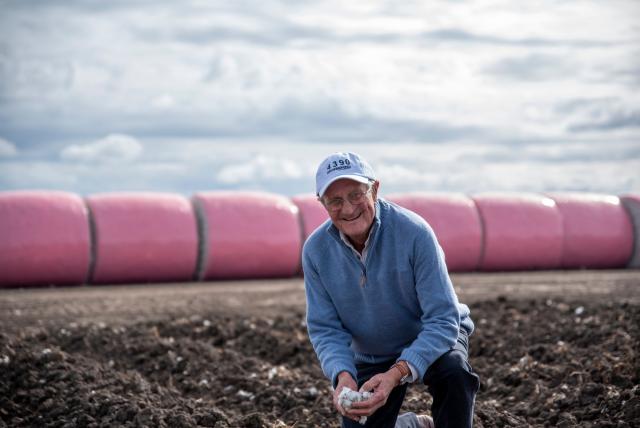I know what you’re thinking – Crikey, someone’s buying my share! That was my immediate response to a new report from the Australian Fashion Council.
The Clothing Data report concludes that a lot of the clothing Australians buy every year ultimately ends up in landfill. As the report shows, 62 per cent of global clothing is made from synthetic materials. They take a long time to break down in landfill, posing a significant environmental risk.
Image: Goondiwindi cotton farmer Sam Coulton, taking part in a cotton waste recycling trial
Cotton Australia teamed up last year with the Queensland Government, Goondiwindi Cotton and others to start a cotton waste recycling trial. The trial diverted about two tonnes of cotton waste from landfill. The waste materials, including Emergency Services coveralls, were shredded and the material spread on a Goondiwindi cotton farm.
A year on, farmer Sam Coulton said the cotton fields at ‘Alcheringa’ easily swallowed up the shredded waste.
“We spread the cotton textile waste a few months before planting in June 2021,” he said in a Cotton Australia media release.
“By January and the middle of the season, the waste had all but disappeared, even at the rate of 50 tonnes to the hectare.”
Soil scientist Dr Oliver Knox said that, at the very least, the trial showed no harm was done to soil health. He said at least 2.070kg of carbon dioxide equivalents was mitigated through the breakdown of garments in the soil rather than in landfill.
“Soil carbon levels remained stable and the soil’s bugs responded well to the added cotton material.”
Cotton Australia’s Brooke Summers said the trial would be replicated in the 2022-2023 season, with the addition of a Gunnedah cotton farm.
Hanes Australasia, owner of many textile brands including Sheridan and Bonds, said the company was keen to add its support.
“We couldn’t be more excited about the success of the trial in Goondiwindi,” Hanes president Tanya Deans said. “To think that we might have a scalable solution for textile waste on our shores is even more exciting.”
Galvanised by the approaching renewables deadline of 2030, the rag trade is driving a national stewardship scheme.
The Australian Fashion Council’s Clothing Data Report reveals that Australia currently imports 1.42 billion units of clothing per year which equates to 373,000 tonnes of cloth.
You’d probably assume, and you’d be right, that locally manufactured clothing forms a tiny proportion of the production, with 38 million items of clothing produced annually.
On an outback trip in 2021, I bought two locally made polo shirts from Goondiwindi Cotton. They were expensive, but I felt so virtuous. Most of our clothing, however, is made in China, India, Indonesia, Bangladesh and emerging markets like Africa.
A good long time ago I was inspired to write a song “Where Do Underpants Come From?” after reading a book by Kiwi author Joe Bennett. I had some friendly correspondence with Joe as my song title was close to what he called his book “Where Underpants Come From.”
Joe was lured into writing the book after paying $8.59 for a five-pack of undies from a discount department store in Christchurch. He also lashed out on a quality pair of ‘Authentics’ for $5.99, then spent the rest of the day thinking – how could anyone possibly make a profit from selling five undies for $8.59?
After an initial rebuff from his agent “Joe, it’s a crap idea. Best, Jim”, Joe set off on an investigative trail. Along the way, he trekked to China and other destinations, following the supply chain from raw materials to manufactured cloth, garment-making, packaging and distribution.
As you may have discovered, if you deliberately go out looking for Australian-made garments, they are not easy to find and more expensive than imported items. When we first moved to Maleny in 2002, the cold winter set me off on a quest for some warm pyjamas. There was still a menswear shop in town at that stage and he showed me a pair of fleecy PJs in a black and white cow pattern. They were expensive and proved to be too warm for Maleny’s relatively mild climate (better suited for Tasmanians).
Quality lasts though, and eight years on I consigned the bottoms (the waistband elastic was gone), to the rag box. I gave the top to a musician friend who loves to dress up when she performs. I hate to think how many cheap pairs of boxers lost their cling and went to the rag box over the ensuing years.
The textile industry is important to Australia’s economy ($27 billion a year) but it is coming at a cost to the environment. The Guardian quoted AFC chief executive, Leila Naja Hibri, who admitted that the fashion industry had a “deserved” reputation for its negative impact on the environment.
“There needs to be a change in the way we design, produce, use and dispose of products,” she said.
The AFC is leading “a consortium of industry disruptors” to create Australia’s first National Product Stewardship Scheme for clothing textiles. The consortium includes brands, manufacturers, retailers, re-use charities, fibre producers, academics and waste management companies. The goal is to improve the design, recovery, reuse and recycling of textiles (with 2030 in mind), with National Waste Policy Action Plan targets.
The AFC has used the report findings to call for a levy on clothing imports to reduce textile waste. At the other end of the fashion cycle, roughly 260,000 tonnes, or 10kg a person, reaches landfill each year, the lead author of the report, Peter Allan, said.
This week I did my bit to help avoid adding textile waste to landfill, dropping off a near-new hoody to a local op shop. Perhaps it was a tight fit to begin with, but a couple of washes later, I’m like a footy player having to get someone to help me don the jersey. As a tape measure-wearing assistant in a jeans shop once said (I was 40-something and shopping for a 30-inch waist), – “Um, you used to be a 30-inch waist. Sorry.”
Bob’s weekly blog Friday on My Mind can be found at www.bobwords.com.au







